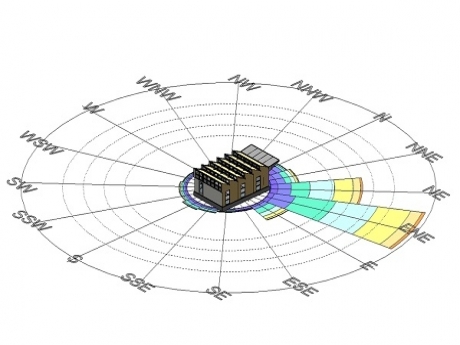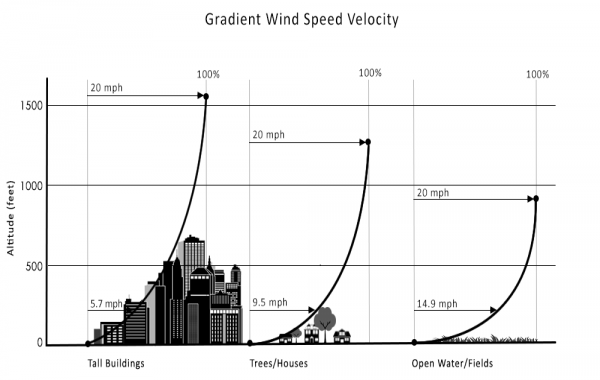You are here
Wind provides natural ventilation and usually cools buildings and people because it accelerates the rate of heat transfer. Wind speed and direction change throughout the day and year, and are not as universally predictable.
 |
Knowing your location's wind patterns influences important environmental and structural considerations. |
As an asset, wind can help facilitate natural ventilation and passively increase occupant comfort – think of a nice breeze on a hot day. The wind can also be harnessed to generate electricity via windmills, although this is typically not as efficient as solar energy for small scale applications.
As a hindrance, wind can drive moisture and water up through small gaps in your building envelope, resulting in potentially devastating consequences if not properly controlled.
Predicting Wind Behavior
Air flows from high pressure to low pressure. This is important to remember because this is the basic principle behind wind ventilation and stack ventilation.
When wind encounters an obstruction, it will flow around the object and continue moving in the same direction. This is similar to the flow of water (both air and water are fluids – See the Metrics and Basics of Fluid Flow). It is important to note that if wind is blocked by a landform or surrounding building, the wind is not stopped, but rather just deflected.
Wind speed varies with height and terrain. As elevation increases, so does wind speed. As terrain becomes rougher, the rate at which wind speed increases slows. This means that the wind speed in an open, rural, environment will increase with height much more quickly than the wind speed in a dense urban center. This rate of increase is known as a wind gradient, or wind profile. As a result, wind velocity can vary between different terrains at the same elevation.
In dense urban environments, wind will reach 100% velocity at a much higher altitude than an open environment with no buildings. This can be seen in the image below.
 |
Wind does not reach full speed until a certain height off the ground; this height depends on the local obstructions.
Sources: rlsenergy.com |
Wind and Microclimates
Environmental surroundings can create microclimates that could significantly alter the wind patterns on your site. Prevailing wind directions can change due to adjacent landforms, buildings, and/or other objects. If you’re in a different microclimate than the nearest weather station, you can’t reliably use that data to guide your design. Features to pay attention to are large bodies of water and changes in elevation. Modeling the surrounding area, and measuring conditions on the actual site, can provide better information on the exact wind conditions of that site.
While microclimates can lead to unpredictable winds, there are some general assumptions that can be made about the behavior of air flow. Near bodies of water, the land is hotter during the day, so as the air over the land gets warmer and rises, it is replaced by cooler air coming from over the water – so the wind blows from the water onto the land. At night, this effect is reversed. The water is warmer than the land, so the air over the water gets warmer and rises and is replaced by the cooler air coming from over the land – so the wind blows from the land to the water.
During the day in a valley, wind will blow uphill because the sun warms the air and causes it to rise. At night, wind will blow downhill because the air is cooled by the cold ground surface causing it to sink into the valley.
Wind Speed
Understanding wind speed is just as important as understanding where the wind is coming from. Wind can gently rustle leaves on a tree, or it can cause severe structural damage to buildings. It all depends on how fast it is moving.
Wind speed is commonly measured in knots, miles per hour, meters per second, or feet per second. There are a host of conversion tools available online (example: NOAA Wind Conversion Tool).
The table below translates wind velocity to visual movement on land. It has been adapted from the Beaufort Wind Scale, a common scale for comparing wind speed that is used in many countries.
Wind Speed |
Description |
Land Conditions |
|
< 1 km/h
< 1 mph
< 1 knot
< 0.3 m/s
|
Calm
(Beaufort #0)
|
Smoke rises vertically |
|
1.1 – 5.5 km/h
1 – 3 mph
1 – 3 knot
0.3 – 1.5 m/s
|
Light air
(Beaufort #1)
|
Smoke drift indicates direction; leaves are still
|
|
5.6 – 11 km/h
4 – 7 mph
4 – 6 knot
1.6 – 3.4 m/s
|
Light breeze
(Beaufort #2)
|
Leaves rustle; wind felt on skin
|
|
12 – 19 km/h
8 – 12 mph
7 – 10 knot
3.5 – 5.4 m/s
|
Gentle breeze
(Beaufort #3)
|
Leaves and small twigs moving; light flags extended
|
|
20 – 28 km/h
13 – 17 mph
11 – 16 knot
5.5 – 7.9 m/s
|
Moderate breeze
(Beaufort #4)
|
Small branches move; dust and loose paper rises
|
|
29 – 38 km/h
18 – 24 mph
17 – 21 knot
8 – 10.7 m/s
|
Fresh breeze
(Beaufort #5)
|
Moderate sized branches move; small trees sway
|
|
39 – 49 km/h
25 – 30 mph
22 – 27 knot
10.8–13.8 m/s
|
Strong breeze
(Beaufort #6)
|
Large branches move; umbrella hard to use
|
|
50 – 61 km/h
31 – 38 mph
28 – 33 knot
13.9 – 17.1 m/s
|
High wind
(Beaufort #7)
|
Whole tree moves; hard to walk against the wind
|
|
62 – 74 km/h
39 – 46 mph
34 – 40 knot
17.2–20.7 m/s
|
Gale
(Beaufort #8)
|
Twigs break from tree; extremely difficult to walk in wind
|
|
75 – 88 km/h
47 – 54 mph
41 – 47 knot
20.8–24.4 m/s
|
Strong gale
(Beaufort #9)
|
Branches break from tree; small trees blow over
|
|
89 – 102 km/h
55 – 63 mph
48 – 55 knot
24.5–28.4 m/s
|
Storm
(Beaufort #10)
|
Trees broken or uprooted; structural damage imminent
|
|
103–117 km/h
64 – 73 mph
56 – 63 knot
28.5–32.6 m/s
|
Violent storm
(Beaufort #11)
|
Widespread vegetation and structural damage
|
|
≥ 118 km/h
≥ 74 mph
≥ 64 knot
≥ 32.7 m/s
|
Hurricane force
(Beaufort #12)
|
Severe widespread vegetation and structural damage
|
